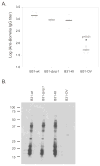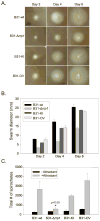The diguanylate cyclase, Rrp1, regulates critical steps in the enzootic cycle of the Lyme disease spirochetes
- PMID: 21542866
- PMCID: PMC3124615
- DOI: 10.1111/j.1365-2958.2011.07687.x
The diguanylate cyclase, Rrp1, regulates critical steps in the enzootic cycle of the Lyme disease spirochetes
Abstract
Rrp1 is the sole c-di-GMP-producing protein (diguanylate cyclase) of Borrelia burgdorferi. To test the hypothesis that Rrp1 regulates critical processes involved in the transmission of spirochetes between ticks and mammals, an rrp1 deletion mutant (B31-Δrrp1) and a strain that constitutively produces elevated levels of Rrp1 (B31-OV) were constructed. The strains were assessed for progression through the enzootic cycle using an Ixodes tick/C3H-HeJ mouse model and tick immersion feeding methods. B31-Δrrp1 infected mice as efficiently as wild type but had altered motility, decreased chemotactic responses to N-acetylglucosamine (NAG) and attenuated ability to disseminate or colonize distal organs. While this strain infected mice, it was not able to survive in ticks. In contrast, B31-OV displayed normal motility patterns and chemotactic responses but was non-infectious in mice. Using immersion feeding techniques, we demonstrate that B31-OV can establish a population in ticks and survive exposure to a natural bloodmeal. The results presented here indicate Rrp1, and by extension, c-di-GMP, are not strictly required for murine infection, but are required for the successful establishment of a productive population of B. burgdorferi in ticks. These analyses provide significant new insight into the genetic regulatory mechanisms of the Lyme disease spirochetes.
© 2011 Blackwell Publishing Ltd.
Figures





References
-
- Amikam D, Galperin MY. PilZ domain is part of the bacterial c-di-GMP binding protein. Bioinformatics. 2006;22:3–6. - PubMed
-
- Antoniani D, Bocci P, Maciag A, Raffaelli N, Landini P. Monitoring of diguanylate cyclase activity and of cyclic-di-GMP biosynthesis by whole-cell assays suitable for high-throughput screening of biofilm inhibitors. Appl Microbiol Biotechnol. 2010;85:1095–1104. - PubMed
Publication types
MeSH terms
Substances
Grants and funding
LinkOut - more resources
Full Text Sources
Medical

